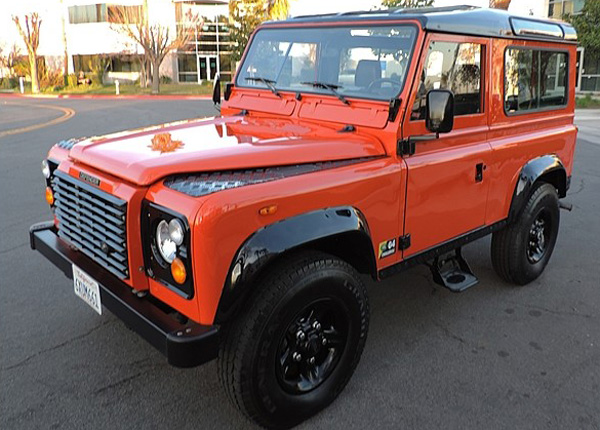Most Awesome 4x4 Trucks Ever Made |
Sold for $43,000 on June 14, 2014 Rare factory 2.5 liter turbo diesel engine Custom Orange paint European market D90 Hardtop wagon Rear jump seat |
|
1997 Land Rover Defender 90 |
|
|
Production of the model now known as the Defender began in 1983 as the Land Rover 110, a name which reflected the 110-inch (2,800 mm) length of the wheelbase. The Land Rover 90, with 93-inch (2,362 mm) wheelbase, and Land Rover 127, with 127-inch (3,226 mm) wheelbase, soon followed. Outwardly, there is little to distinguish the post-1983 vehicles from the Series III Land Rover. A full-length bonnet, revised grille, plus the fitting of wheel arch extensions to cover wider-track axles are the most noticeable changes. Initially the Land Rover was also available with a part-time 4WD system familiar to all derivatives produced since 1949. The part-time system failed to sell and was quickly dropped from the options list by 1984. While the engine and other body panels carried over from the Series III, mechanically the 90 and 110 were modernized, including:
Coil springs, offering a more comfortable ride and improved axle
articulation This period saw Land Rover market the utility Land Rover as a private recreational vehicle. While the basic pick-up, station wagon and van versions were still working vehicles, the County station wagons were sold as multi-purpose family vehicles, featuring improved interior trim and more comfortable seats. This change was reflected in Land Rover starting what had long been common practice in the car industry — detail changes and improvements to the County model from year to year in order to attract new buyers and to encourage existing owners to trade in for a new vehicle. These changes included different exterior styling graphics and color options, and the introduction of new options, such as radio-cassette players, styled wheels, headlamp wash and wipe systems, as well as accessories such as surfboard carriers and bike racks. The switch from leaf spring to coil spring suspension was a key part of the new model's success. It offered improved off-road ability, load capacity, handling, and ride comfort. The biggest change to the Land Rover came in late 1990, when it became the Land Rover Defender, instead of the Land Rover Ninety or One Ten. This was because in 1989 the company had introduced the Discovery model, requiring the original Land Rover to acquire a name. The Discovery also had a new turbodiesel engine. This was also loosely based on the existing 2.5-litre turbo unit, and was built on the same production line, but had a modern alloy cylinder head, improved turbocharging, intercooling and direct injection. It retained the block, crankshaft, main bearings, cambelt system, and other ancillaries as the Diesel Turbo. The breather system included an oil separator filter to remove oil from the air in the system, thus finally solving the Diesel Turbo's main weakness of re-breathing its own sump oil. The 200Tdi, as the new engine was called, produced 107 hp (80 kW) and 195 lb·ft (264 N·m) of torque, which was nearly a 25% improvement on the engine it replaced (although as installed in the Defender the engine was de-tuned slightly from its original Discovery 111 hp (83 kW) specification due to changes associated with the turbo position and exhaust routing). Of note from an investor stand point these vehicles have basically doubled their value since they were sold new in the mid-1990's. They are no longer sold in the U.S. as new. |

